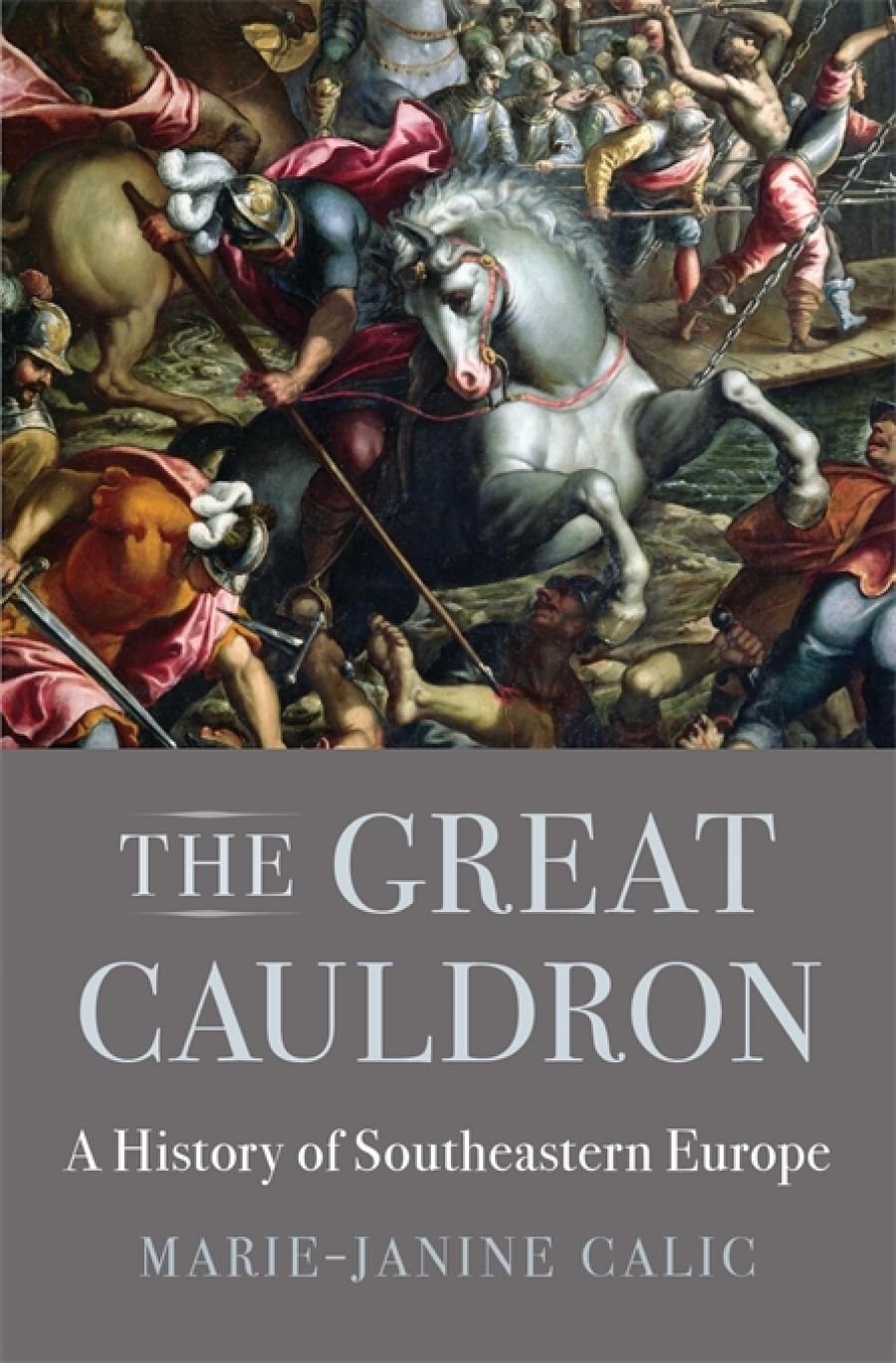
- Free Article: No
- Contents Category: History
- Review Article: Yes
- Online Only: No
- Grid Image (300px * 250px):

- Alt Tag (Grid Image): The Great Cauldron
- Book 1 Title: The Great Cauldron
- Book 1 Subtitle: A history of southeastern Europe
- Book 1 Biblio: Harvard University Press (Footprint), $89 hb, 734 pp, 9780674983922
The study opens with an examination of the region’s earliest recorded history and its emergence as the titular great cauldron of peoples, languages, alphabets, beliefs, and religions. The rise of Christianity in late antiquity is here treated as one of the original global forces that shaped the profile of southeastern Europe. Yet although Christianity had a decisive influence, Calic insists that its impact was by no means uniform – for centuries the region remained not only a battleground between Latin and Byzantine Christian practices, but also a centre of one of the most influential pan-European heretical movements. In illustrating how mega-trends such as the rise of Christianity manifested themselves differently across the region’s uneven terrain, Calic sets a strong basis for a historical analysis that treats south-eastern Europe in its own right, rather than as the West’s Other. The region’s integration into the networks of early merchant capitalism – an intricate web of trade, knowledge exchange, migration, and pilgrimage – is given similarly detailed treatment.
While the age of empires saw these lands divided between Ottoman and Habsburg rule, The Great Cauldron again sets aside the habitual framing of south-eastern Europe as a border zone. Instead, the region and its inhabitants are positioned as nodes within a transcontinental imperial network, which, in the case of the Ottoman Empire, spanned from Morocco to Iran, and from the gates of Vienna to Mecca. Calic’s examination of the impact of geographic discovery and transatlantic trade on the Ottoman Empire is especially intriguing, in that it reveals how an inflexible response to shifting patterns of global trade left a permanent imprint on the economic development of the territories under Ottoman rule. In perhaps the book’s most enthralling use of micro-history, Calic zeros in on the Croatian coastal city of Ragusa (Dubrovnik) in 1776 – the year of America’s declaration of independence. As ruling élites grapple to understand how this development might impact the city’s position within global maritime trade, Calic shifts her attention to popular forms of leisure in Ragusa, and the story of a local monk playing soccer in front of his church to the amusement of curious onlookers. These vignettes serve as a subtle reminder that, for the vast majority, there is often something profoundly abstract about even the most significant of global shifts.
 Marie-Janine Calic (photograph via the European Network Remembrance and Solidarity)
Marie-Janine Calic (photograph via the European Network Remembrance and Solidarity)
Of course, both the American and subsequent French Revolution were major sources of inspiration for those seeking independence from their Ottoman or Habsburg rulers. Yet while the heroic fight for national liberation would provide ample material for Romantic poets and artists across Europe – and famously prompted Lord Byron to join the Greek War of Independence against the Ottomans – Calic’s account of the emergence of nation states in south-eastern Europe is anything but romantic. Here the author methodically maps out the vectors of violence that led to the collapse of the great empires and the rise of new sovereign states. The Great Cauldron does an admirable job of tracing how the extreme violence that accompanied various wars of independence in south-eastern Europe inspired genuine international efforts to define strategies for modern conflict management, while also giving way to the stereotypes of this region as quintessentially backward and anarchic. This characterisation would, of course, be repeatedly deployed throughout the twentieth century to justify military and political intervention by global powers seeking to promote or secure their own interests across the region.
Calic’s positioning of south-eastern Europe within the global history of the Cold War period unfolds mainly through an account of socialist Yugoslavia and its role as the founder of the Non-Aligned Movement – an organisation of countries not formally aligned with either of the major power blocs. This involvement brought the region into direct contact with numerous other countries (particularly those of the ‘Global South’) and thus opened new channels of economic and cultural exchange. Similarly, in examining the fall of communist regimes across south-eastern Europe, Calic trains her focus on the Yugoslav experience, as both the fratricidal war that followed its dissolution and the subsequent revolutions in its successor states redefined, for better or worse, international instruments of conflict resolution.
Informed, comprehensive, and methodical, The Great Cauldron provides valuable insight into south-eastern Europe and its turbulent past. While it presumes a level of subject matter familiarity from its readers in some parts and flattens complex issues in others, for the most part Calic provides an artful and engaging narrative. Its conclusion, however, is somewhat lacking. In seeking to deal with the region’s recent (and, in some cases, pending) integration into the European Union, Calic avoids critical engagement with what has largely been a traumatic and uneven process. Furthermore, her failure to better integrate the stories of women who shaped this history represents a lost opportunity to unsettle not only geographic but also gender assumptions about the region. Ultimately, The Great Cauldron is a valuable resource for reframing established categories of centre and periphery, and it provides important insight into a part of the world that has always been globally connected.


Comments powered by CComment